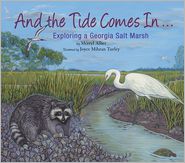 |
And the Tide Comes In…Exploring a Georgia Salt Marsh Merryl Alber Illustrated by Joyce Mihran Turley And the Tide Comes In… Exploring a Georgia Salt Marsh is a children’s picture book in which a young girl shows her visiting cousin the beautiful local salt marsh, and teaches her about its ecological complexity, including the twice-daily tides that submerge it! From the life cycles of shrimp and snails, to roaming raccoons and skittering crabs, the salt marsh is shared by a wide variety of amazing and busy animals! The story is told in the style of a friendly narrative, supplemented with fact-filled sidebars. “All salt marshes are covered by salty water brought in from the ocean during high tide, and exposed to the air during low tide. Although the particular plants and animals found in marshes do differ from one area to another, they are all shared by land and marine animals, and they’re all covered by grasses that can withstand getting flooded by salt water.” Wonderful color illustrations enhance this enjoyable and educational treasury, highly recommended especially for public library children’s collections. 2012, Taylor Trade Publishing, Ages 8 to 11, $15.95. REVIEWER: Midwest Book Review (Children’s Bookwatch).
ISBN: 9780981770055 |
 |
And Then It’s Spring Julie Fogliano Illustrated by Erin E. Stead A bespectacled lad in a red scarf and mittens surveys the brown of an early spring landscape, plants a few seeds and waits. With every page turn, as the season advances, the boy’s attire changes from rain slicker to blue jacket to striped t-shirt and the earth evolves from a “hopeful” brown to a “greenish hum” underground to a rich, lively green. The text by first-time author Julie Fogliano is spare and soft as a breath, with the story drama being carried largely by Erin Stead’s illustrations. As she did so beautifully in A Sick Day for Amos McGee (Caldecott Medal 2011), Stead conveys changes in mood and time through her color palette and the result is well paced and visually arresting. 2012, Roaring Brook/Macmillan, Ages 3 to 7, $16.99. REVIEWER: Mary Quattlebaum (Children’s Literature). ISBN: 9781596436244 |
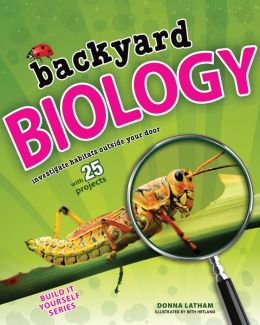 |
Backyard Biology: Investigate Habitats Outside Your Door with 25 Projects Donna Latham This addition to the Build It Yourself series incorporates 25 projects for kids to try as they explore the “ecosystems that are outside your door.” The book’s eight chapters cover biology (and microbiology), cells, and the life cycles of both plants and animals, among other topics; definitions of key terms appear throughout, as do Hetland’s cartoons and diagrams. Latham’s accessible, encouraging tone, along with such experiments as creating habitats for woodlice (aka roly-polies) and building bird nests using natural materials, should pique kids’ interest and get them outdoors. 2013, Nomad Press, Ages 9–12, $15.95. REVIEWER: Publishers Weekly. ISBN: 9781619301511 |
 |
Bug Patrol Denise Dowling Mortenson Illustrated by Cece Bell Cece Bell provides fun illustrations for Bug Patrol, which follows Captain Bob the bug as he’s on the beat getting bugs out of trouble in a busy world. His first job, a donut attack by rude urban ants, is quickly solved by enforcing manners – and beetle bumping at the mall is treated with admonishments to be more patient with fellow bugs. A whimsical dialogue and fun encounters make this a winning pick for beginning readers. 2012, Clarion Books, Ages 4+, $16.99. REVIEWER: Midwest Book Review (Children’s Bookwatch). ISBN: 9780618790241 |
 |
Citizen Scientists: Be a Part of Scientific Discovery From Your Own Backyard Loree Griffin Burns Photographs by Ellen Harasimowicz The subtitle on the cover gives a big clue as to the contents: “Be a part of scientific discovery from your own backyard.” The definitions of a citizen, science and citizen science are presented in the introduction. Everyday people who use their senses and smarts to understand the world can be citizen scientists. There are four major sections which follow the seasons and start with fall. During the fall keep your eyes open for butterflies and follow the directions for capturing one in your butterfly net, carefully remove it and study the four wings and especially the beautiful markings–sometimes you may find that you have caught a lookalike, but that is fine too. If you want a bigger challenge determine what sex the butterfly is by again following the explanation and directions in the text. Only males have scent pouches. Next tag the butterfly and then let it go free. It was through this tagging that Dr. Fred Urquhart was able to determine when monarchs spent the winter and with the help of hundreds of citizens he was able to determine the two migratory paths depending on whether the monarchs lived to the east or west of the Rocky Mountains. There is much more information about the butterflies and birds, frogs and ladybugs in the other sections of the book. The text is engaging and informative. The illustrations which are mostly photographs are excellent and of high quality. This is a science book that will definitely lure in young readers and they will leave them anxious to participate and be informed about these creatures that for the most part live right in our backyards. 2012, Henry Holt, Ages 8 to 12, $19.99. REVIEWER: Marilyn Courtot (Children’s Literature). ISBN: 9780805090628 |
 |
Frog Song by Brenda Guiberson Illustrations by Gennady Spirin The team behind Life in the Boreal Forest focuses on a single animal: frogs. The magnificently gifted Spirin paints larger-than-life portraits of 11 frog species from every corner of the world, showing the texture of their skin and the gleam of their eyes in intricately worked, tapestry-like spreads. Many of the frogs have unique, even startling childbearing behaviors. In some species, males tend the developing frog eggs. The Darwin’s frog, from Chile, wins the prize for the strangest place to keep them: “They slither into his vocal sacs, where he keeps them safe and moist for 7 weeks. Then he gives a big yawn, and little froglets pop out.” The consciousness of the fragility of frogs and their dependence on clean air and water to survive is emphasized throughout. Guiberson speaks of frog voices as a beacon, a signal of the Earth’s continued health: “A frog song is a celebration of clean water, plants, and insects to eat. Chiroop. Pribble!” Back matter supplies additional information about frog species, resources, and threats. Spirin’s paintings make this a book to treasure. 2012, Henry Holt, Ages 4–8, $17.99. REVIEWER: Publishers Weekly. ISBN: 9780805092547 |
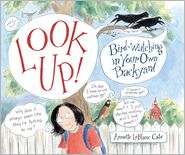 |
Look Up!: Bird-Watching in Your Own Backyard Annette LeBlanc Cate Cate has packed this small format book with all sorts of information about birding and lots of humor. She makes no presumptions about the reader’s interest but is sure to draw them in with her chatty style and humorous sketches. She starts small, with emphasizing just looking around where you live, whether it be city, suburb, or country, and gives basic tips about what to do and bring, using a minimalist approach. Readers are encouraged to sketch, look and focus—observing shape, size, plumage, behavior, sounds, habitat, and even migration. Birds banter in dialogue balloons, adding more information to the text. Cate’s chatty style keeps readers going; they won’t want to skip a single page for fear of missing some of the repartee. While the pages appear jam-packed with the pen-and-ink and watercolor illustrations, the captivating illustrations are such fun that it’s OK. It’s the kind of book that a reader can read cover-to-cover or put down, even for weeks, and still be learning from it. Her enthusiasm is catching and youngsters will return to these pages again and again. Hopefully they follow her advice to draw, draw, draw. An annotated bibliography, index, and tips for drawing complete this excellent nonfiction book. 2013, Candlewick, Ages 8 to 12, $18.00. REVIEWER: Peg Glisson(Children’s Literature) ISBN: 9780763645618 |
 |
Nasty Bugs : Poems Compiled by Lee Bennett Hopkins Illustrated by Will Terry Sixteen poems, three of which were commissioned for this book, inform and entertain readers. Poets include Hopkins, X. J. Kennedy, Marilyn Singer, J. Patrick Lewis, Alice Schertle, Douglas Florian, and several other well-known poets. Their creatures bite and suck their ways through plants, animals, humans, and other things like wood in poems of free verse or tight rhythm and rhyme. The vocabulary is marvelous, with inventive words such as “yum-yucky” and “pediculous;” descriptive terms such as writhing, stealthy, and blood-filled; and rich language filled with words like armament, marbled, gobble, and genealogy. These poems aren’t just for fun, though, as they are packed with information about the bugs’ modus operandi and/or consequences of their actions. Many familiar insects, including bedbugs, fleas, lice, mosquitoes, and wasps, are included along with some less familiar insects (boll weevil, potato beetle, chigger). Will Terry’s brightly colored illustrations mostly fill the pages, with the poems lying over each illustration. His bugs feature exaggerated eyes, legs, and stingers as they skitter, crawl, or eat their way across each page. His focus is always the bug’s line and shape, but each drawing is filled with other details to add to the ick-factor. His perspectives vary and draw the reader into the situation. I guarantee these poems and illustrations will have you scratching before the end of the book! Three pages of information on each bug are an added plus; this back matter includes a thumbprint size illustration, a one-liner from the poem, each bug’s scientific name or order, and facts about each bug. The poems read aloud well and offer some opportunities for dramatic readings. This is not just for budding entomologists; even those grossed out by bugs of all shapes and sizes will be smiling as they learn. 2012, Dial/Penguin, Ages 5 to 9, $17.99. REVIEWER: Peg Glisson (Children’s Literature). ISBN: 9780803737167 |
 |
Plant a Little Seed Bonnie Christensen Planting a little seed, taking care to give it the things it needs like water and weeding, also takes a lot of patience–or as this lovely picture book says, a lot of waiting and dreaming as the seed takes its time to send down roots and send up sprouts and leaves; eventually the fruits and vegetables begin to show and grow. In autumn, all that dreaming and waiting ends up in a harvest of the garden’s gifts. Some will be pickled, baked, frozen or dried but there will be plenty for a glorious autumn feast with family and friends. Christensen’s simple lyrical text recounts the garden growing cycle. However, her wood cut illustrations contribute strongly to the magic of a garden. She follows two children, a blond girl and dark-skinned boy who begin by planting and end by using the seeds from last year’s produce to plant a new garden the following spring. These two are shown doing the all-important job of waiting and dreaming. This is an excellent book for early childhood classrooms (Pre-k to 3rd) that are exploring plants or doing an inquiry around food, especially if they are looking at the farm to table cycle. 2012, Roaring Brook Press, Ages 5 to 8, $17.99. REVIEWER: Mary Hynes-Berry (Children’s Literature). ISBN: 9781596435506 |
 |
Pug: And Other Animal Poems Valerie Worth Pictures by Steve Jenkins Following up on Animal Poems, Jenkins again selects an array of elegant free verse by classic twentieth-century poet Valerie Worth, combining each of the eighteen verses with a dramatic cut-paper portrait of its animal subject. Worth’s poems are precise and gemlike in their glittering compactness; some are gently playful (pugs are “what/ Some people/ Might call plug-ugly/ Perhaps because, for/ Dogs, they look/ A lot like people”), others reach heights of grandeur (“The bull/ Would not/ Melt: but/ Had to be/ Hacked out,/ Rough-hewn,/ From the planet’s/ Hard side”), and all display her delight in consonance, assonance, and careful wordsmithing. Jenkins ramps up the impact with compositions of tight focus, posing animals mostly against contrasting backdrops of solid rich color (the bull’s dark bulk looms across a three-quarter spread of flame red; a firefly, lacework wings in stop-motion stillness mid-flight, floats in a sea of nocturnal dark blue). His birds especially transcend the static genre, with geese bodies contracting and flexing as they soar and pigeons’ wing-beats fluttering across a city skyline. The sonorousness of the poems make them terrific readalouds, their compactness and engaging subject will appeal to reluctant readers, and their craftsmanship will draw established poetry fans. 2013, Ferguson/Farrar, Grades 3-7, $16.99. Grades 3-7. REVIEWER: Deborah Stevenson (The Bulletin of the Center for Children’s Books). ISBN: 9780374350246 |
 |
Secrets of the Garden: Food Chains and the Food Web in Our Backyard Kathleen Weidner Zoehfeld Illustrated by Priscilla Lamont Gardens green and growing–both author and illustrator have been inspired by special ones. Zoehfeld remembers her mother’s carrots, sweet peas, and tomatoes, while Lamont’s garden in England’s Kent produces spinach, apples, and plums. Their collaboration blossoms, too, as young Alice (named perhaps after Alice Waters, creator of the “Edible Schoolyard”) works with her family to plant seeds in spring, water them, and watch them sprout. Each member has his or her own plot; Alice plants zucchini, radishes, and carrots. As the season progresses, two feisty and very well-informed hens explain to readers the intricacies of food chains they can see in their own gardens. Lamont’s gorgeous watercolors bring to life the luscious vegetables, predators like hawks, and prey like mice (the cat, Honey, is especially fond of them). Bugs are of interest, too, as ladybugs, spiders, caterpillars, and potato bugs are investigated and pictured by Lamont (earthworms, too). Summer brings harvests and a flurry of canning tomatoes, pickling beans, and freezing corn for the winter, when the family plans next year’s garden (strawberries? pumpkins?) in their snug wooden farmhouse. Especially appealing are a page that follows an underground earthworm tunnel with winding words, the garden’s food web charted by the chickens, and lovely endpapers showing a painted plan of house, yard, and garden plots, where plants, animals, and humans come together to make their own teeming ecosystem. Presented with imagination, humor, and love by two talented artists, these garden secrets will work their magic in the classroom, for a family, or as a very special gift for a young gardener. 2012, Knopf/Random House, Ages 5 to 10, $16.99. REVIEWER: Barbara L. Talcroft (Children’s Literature). ISBN: 9780517709900 |
 |
Seeds, Bees, Butterflies, and More! : Poems For Two Voices Carole Gerber Illustrated by Eugene Yelchin Yelchin’s cheerful gouache illustrations call to mind sidewalk chalk art in this collection of nature- and spring-themed poems designed to be recited by two readers. The poems’ alternating parts are differentiated by color, with multicolored phrases intended to be read in unison. Gerber’s poems are casually conversational (“It’s springtime!/ Will you be up soon?/ I feel sure you’ll be cute,” a hungry rabbit urges a green sprout), while she sneaks in a surprising amount of information about flowers, berries, bugs, and more, as well as topics including germination and pollination. The airy poems are pleasing, but maybe not perennial. 2013, Henry Holt, Ages 4–up, $17.99. REVIEWER: Publishers Weekly.
ISBN: 9780805092110 |
 |
Spring Blossoms Carole Gerber Illustrated by Leslie Evans Cataloging in Publication Watertown, MA : Charlesbridge, 2013. Bright magenta and pink cherry blossoms reach out to a high-swinging girl in a deep pink top and sandals—it is spring! Open the book for a blast of brilliant new-leaf green as the girl and a friend in turquoise take off for the park to check out the trees, “dressed up for their yearly show.” The predominant color is the pink of cherry, magnolia, and redbud with a deeper rosy-red for red maple blossoms; even the white dogwood and crab apple petals are outlined in pale pink. Beeches and white oaks put forth green-gold flowers in clusters, while the conifers—white pine and balsam fir—sprout tiny yellow blossoms and cones with some touches of pink on female and male flowers hidden under their twigs. As a windy spring rain begins to fall, the girls are showered with pink magnolia petals and race to catch them. Gerber tells the story in rhyming quatrains, two lines to a page, deftly incorporating the information into her verses. Artist Lewis has created her linoleum block prints with watercolor additions in her Maine letterpress studio, producing an overall impression of spring in its pink and delicate green garb, not exactly realistic but making use of line and color to evoke the season. The girls provide action to move the tale along and keep the pages turning. Especially decorative is a double-page layout of stylized flowers from each of the ten trees. Since further information about tree lifecycles is added for teachers or parents, the book would make a wonderful introduction for a spring field trip to a park or botanical garden, though these are mainly eastern or northeastern trees. Spring is different in other environments. REVIEWER: Barbara L. Talcroft (Children’s Literature). ISBN: 9781580894128 |
 |
A Stick is an Excellent Thing: Poems Celebrating Outdoor Play Marilyn Singer Illustrated by LeUyen Pham Boys and girls go outside to enjoy all kinds of outdoor games from morning to night. There is a jolly poem for each activity, from playing ball and racing: “Everything’s a blast / when you do it really fast,” jacks and bubble-blowing, jumping rope and swinging, to running in the sprinkler, hide-and-seek, hopscotch, and catching fireflies. Each activity is celebrated with joy, an encouragement to youngsters to get out of the house into the great outdoors. Pham creates a festive cast of kids engaging playfully in the various games. The double-page scenes focus on them and such simple props as a splashing sprinkler, an upside down world as seen from the monkey bars, or a spinning basketball over some outstretched hands. There is a clean-cut style to the pencil and ink figures generated digitally that liberates them from the mostly solid colored backgrounds, adding to the energetic projections. 2012, Clarion Books/Houghton Mifflin Harcourt, Ages 4 to 8, $16.99. REVIEWERS: Ken Marantz and Sylvia Marantz (Children’s Literature). ISBN: 9780547124933 |
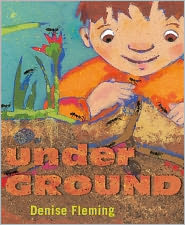 |
Underground Denise Fleming Spare poetic text describes the multitude of activities that can be found taking place beneath the soil: “Creatures dig/ and run around./ Past highways and byways./ Squirm-ways and worm-ways./ Digging furrows and burrows,/ round roots and bones,/ rocks and stones.” A rhyming refrain (“Low down./ Way down./ Underground”) opens and closes this introduction to animal life under the dirt, and a closing spread helpfully names and describes the various creatures that are depicted throughout the book. The information presented in this end matter is brief and concise in accordance with its youthful audience, and the thumbnail illustrations will prove immensely useful to readers, who may have some trouble identifying a few of the animals pictured on the previous pages. It can occasionally be a bit tricky to find the burrowing creatures amid the earth they inhabit, so viewers will appreciate additional time for closer exploration; the intriguing inclusion of “copy transfer elements, such as a photocopied key, toy car, or wrench that are “hidden” in the soil, also add further reward for poring over the pages. Despite the slight visual confusion of some pictures, this is a very serviceable and age-appropriate introduction to studies of underground fauna, and a fine book to share before going outside to dig in the dirt. 2012, Beach Lane/Simon, Ages 3 to 6 yrs, $17.99. REVIEWER: Jeannette Hulick (The Bulletin of the Center for Children’s Books). ISBN: 9781442458826 |
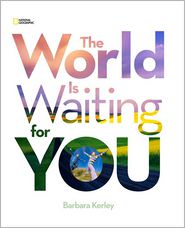 |
The World is Waiting For You Barbara Kerley As she did in One World, One Day, Kerley pairs lean prose with exquisite photographs (many from National Geographic’s archives) in this exuberant celebration of the boundless possibilities life holds for children. As in the earlier book, smaller versions of the photos also appear at book’s end, annotated with information about the activities and locations depicted, as well as comments from the photographers. Kerley uses two visual narratives to encourage readers to explore the world around them. Photographs of children involved in outdoor activities alternate with thematically linked images of scientists and adventurers. A photograph of a child playing under a waterfall in Bali (“Make a splash. Get a little too wet”) is followed by a shot of oceanographer Sylvia Earle diving with dolphins near the Bahamas (“Dive in”); an image of a girl standing on a Florida beach (“face the wind…”) leads into a shot of a biologist/photographer paragliding over Patagonia (“…and soar”). Whether portraying an everyday activity or an extraordinary feat of science and exploration, the daring photographs and invigorating text aim to inspire—and succeed. 2013, National Geographic, Ages 4–8, $17.95. REVIEWER: Publishers Weekly. ISBN: 9781426311147 |
Nature
 |
Nature Nature is a wonderful teacher. Studying nature increases observation skills and the capacity to understand the unknown, while also cultivating a love of investigation, fostering a sense of ownership and stewardship of the earth, and soothing the soul. Whether it’s wilderness or “nearby nature,” there’s something in nature for everyone! Web links to additional information and activities about humor follow these reviews.
Contributor: Peg Glisson |
Reviews
|



